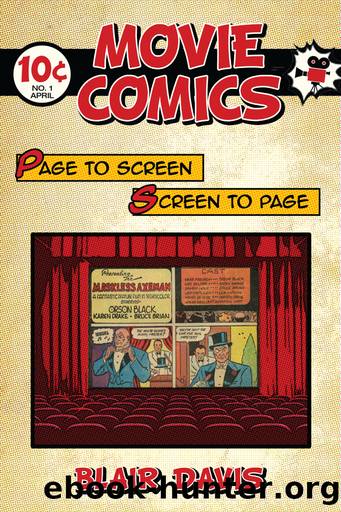Movie Comics by Davis Blair

Author:Davis, Blair [Davis, Blair]
Language: eng
Format: epub
Publisher: Rutgers University Press
Published: 2016-06-14T16:00:00+00:00
FIGURE 34. John Wayne appears as himself in the pages of John Wayne Adventure Comics #1 (Winter 1949).
While the book’s cover boasted the tagline “The Greatest Cowboy Star of Them All!” readers were occasionally offered a war tale in keeping with Wayne’s popularity in such films as Back to Bataan (1945), They Were Expendable (1945), and Sands of Iwo Jima (1949). Issue fourteen uses an image from the Sands of Iwo Jima poster of Wayne charging with a bayonet, the publisher hoping to capture fans of Wayne’s different film genre efforts. The issue begins with a story set during the Korean War entitled “Operation Peeping John,” as our narrator tells us of how “the orders called for a mission loaded with the smell of death. The assignment sends Wayne behind enemy lines with orders to dig in under the noses of the enemy . . . and sweat out the mission of observation that makes him a . . . Peeping John!” The story ends with a nurse telling an injured Wayne that he should be discharged soon: “With the new regulations, most of the reservists will be getting out!” The final panel shows Wayne thinking to himself, “I hate to leave those boys back here in Korea—but I’ll never forget them—even though it’ll be good to get back on the range.”41
This forced attempt at creating continuity between his western and war adventures furthers the book’s illusion that Wayne’s offscreen exploits were as thrilling as his cinematic ones. He is not referred to as a movie star in the comic, nor are any of his films directly invoked in the stories, but various characters nevertheless recognize him and are star-struck (“Why . . . why you’re John Wayne!” says one sheriff, adding, “I thought you might be th’ thief we’re after. I didn’t know it was you, Mr. Wayne”).42 The series therefore serves to bolster Wayne’s larger-than-life persona as “The Duke,” offering readers tales of derring-do that support his screen image.
Wayne was one of the biggest movie stars of the period, and the fact that he had his own comic demonstrates that such books were not just reserved for B-film stars and animated characters. Comics featuring movie stars helped to solidify the image or character type that actors constructed for themselves (or which their studios created for them). In the case of both Alan Ladd and John Wayne, their comics were used to position the actors as rugged heroes both onscreen and off, with the books boasting of their virility and manliness as a way of boosting their star power in a way similar to that of other publicity outlets like fan magazines. In this case, however, narratives are used to sell the public on the potency of these movie stars, with such stories offering visual entertainment rather than prosaic journalism as a way for film fans to extend their enjoyment of their favorite screen stars.
While there were numerous series featuring a wide range of movie stars by the late 1940s, full-length movie adaptations in comic book form were still rare throughout the decade.
Download
This site does not store any files on its server. We only index and link to content provided by other sites. Please contact the content providers to delete copyright contents if any and email us, we'll remove relevant links or contents immediately.
Wonder by R.J. Palacio(8446)
Mastering Adobe Animate 2023 - Third Edition by Joseph Labrecque(3758)
Unlabel: Selling You Without Selling Out by Marc Ecko(3587)
Ogilvy on Advertising by David Ogilvy(3503)
Hidden Persuasion: 33 psychological influence techniques in advertising by Marc Andrews & Matthijs van Leeuwen & Rick van Baaren(3472)
Drawing Cutting Edge Anatomy by Christopher Hart(3453)
The Pixar Touch by David A. Price(3362)
POP by Steven Heller(3307)
The Code Book by Simon Singh(3073)
The Art of War Visualized by Jessica Hagy(2943)
Slugfest by Reed Tucker(2937)
The Curated Closet by Anuschka Rees(2911)
Rapid Viz: A New Method for the Rapid Visualization of Ideas by Kurt Hanks & Larry Belliston(2832)
Stacked Decks by The Rotenberg Collection(2810)
365 Days of Wonder by R.J. Palacio(2751)
The Wardrobe Wakeup by Lois Joy Johnson(2731)
Keep Going by Austin Kleon(2696)
Tattoo Art by Doralba Picerno(2599)
Tell Me More by Kelly Corrigan(2591)
